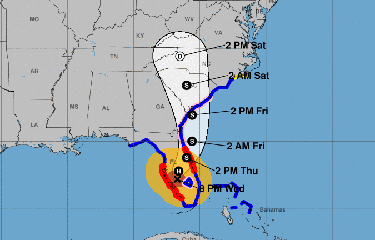Spinning out wind gusts to 190 miles per hour, Hurricane Ian made landfall at 3:05 p.m. Wednesday, 28 September, near Cayo Costa State Park on the southwest coast of the U.S. state of Florida, pushing storm surges that swamped neighborhoods in the city of Fort Myers and moving inland into the evening.
Record surges rolled into the streets of Key West and Naples as Ian made its way north overnight into Wednesday as a powerful category-four storm, with sustained winds to 155 miles per hour. Authorities warned that surges as high as 12 feet could continue into Thursday, 29 September. A tide gauge at Bonita Beach reported a rise to more than 10 feet around 6:15 p.m. as Ian weakened to a category-three storm and pushed northeast toward Orlando.
NOAA National Weather Service flood gauges indicated major flooding at multiple locations in the storm’s path on Thursday morning, with flooding across the entire Florida peninsula.
With continuing high water and an estimated two million electrical customers out of power, curfews were imposed from Naples north to Tampa. The industry group Edison Electric Institute said 33,000 utility workers in 31 states are mobilized to assist in the post-storm recovery.
Winds were forecast to slowly ease as the storm makes its way across the Florida peninsula, but the system is predicted to broaden into a wider, prolonged rain event.
At a press conference early Thursday morning, Florida Governor Ron DeSantis said first responders were deployed as quickly as possible in the wake of the storm.
“As soon as that storm passed in the very wee hours of the morning, first responders from the local state and federal level descended on southwest Florida. The coast guard has been performing rescue missions on the barrier islands consistently,” he said.
DeSantis said the rescue efforts started with the barrier islands and will move inland toward areas with the worst flooding. Air assets, including helicopters, have been deployed to rescue anyone stranded.
“As of 6 a.m. this morning, we have 2.02 million reported power outages,” DeSantis said. He added that Florida counties of Lee and Charlotte are “basically off the grid” following the storm.
DeSantis said communications infrastructure in those counties had been largely cut-off due to the storm, and that in response, 100 portable cell towers are being deployed in the hardest-hit areas. Main highway routes into and out of many of the areas remained open, DeSantis said, and the state has deployed a team of 100 engineers to inspect bridges in the area to ensure they are structurally sound.
“We do have reports of structural damage to bridges,” DeSantis said. “Once bridges are inspected and determined to be safe, they will be reopened as soon as possible.”
DeSantis said the state has been granted federal assistance up front for 30 days so that the rescue and repair efforts can quickly move forward.
The port of Tampa had been closed as Ian approached, and shortly before landfall on the gulf side of the state, the Coast Guard closed the port pending the storm’s passage. Forecasters predict the hurricane will move out onto the Atlantic as a tropical storm, before moving northwestward toward the South Carolina coast – potentially re-strengthening to a category-one hurricane.
Preparing for rescue and response operations, the Coast Guard Seventh District established an area command post at the Coast Guard air station at Opa Locka in Miami-Dade County.
“The Coast Guard is here and ready to fully support the state of Florida in our shared response to Hurricane Ian,” said Capt. Nicolette Vaughan, chief of prevention for the Seventh Coast Guard District and IMT area commander for the Hurricane Ian incident response team. “Our primary focus is to rescue those in distress. Our next focus will be to reopen the ports affected as soon as possible to ensure vital resources and supplies are delivered where they are most needed.”
The Seventh District has mobilized and prepositioned units across Florida, prepared to surge into damaged areas for search and rescue resources. Port reconstitution teams are standing by to restore maritime infrastructure. A list of assets now committed includes:
- Aircraft: 21 rotary wing and 9 fixed wing aircraft able to locate and rescue persons in distress.
- Cutters: 31 multi-mission search and rescue ships, 4 buoy tenders and 3 construction tenders to service aids to navigation.
- Flood response teams: 40 shallow-water response teams able to access those stranded by the storm surge and heavy rain.
“Post storm, crews will take to the water, assessing port conditions, identifying safety concerns to protect mariners and restore the maritime commerce and tourism industries that Florida depends upon,” the U.S. Coast Guard said in a statement.
As a powerful category-four hurricane, approaching category-five status, with gusts to 190 miles per hour, Ian appears on track to rival Hurricane Andrew in 1992 as a historically damaging storm for Florida.
Thirty years after Andrew, southwest Florida’s population and urban development has swelled. Cape Coral, and extensive canal-front residential community east of Fort Myers, and island communities like Pine Island and Sanibel lay exposed to the storm’s strongest winds in the peak flood zone extending northward toward Sarasota.
Reporting by Kirk Moore and Chris Chase
Image courtesy of NOAA







